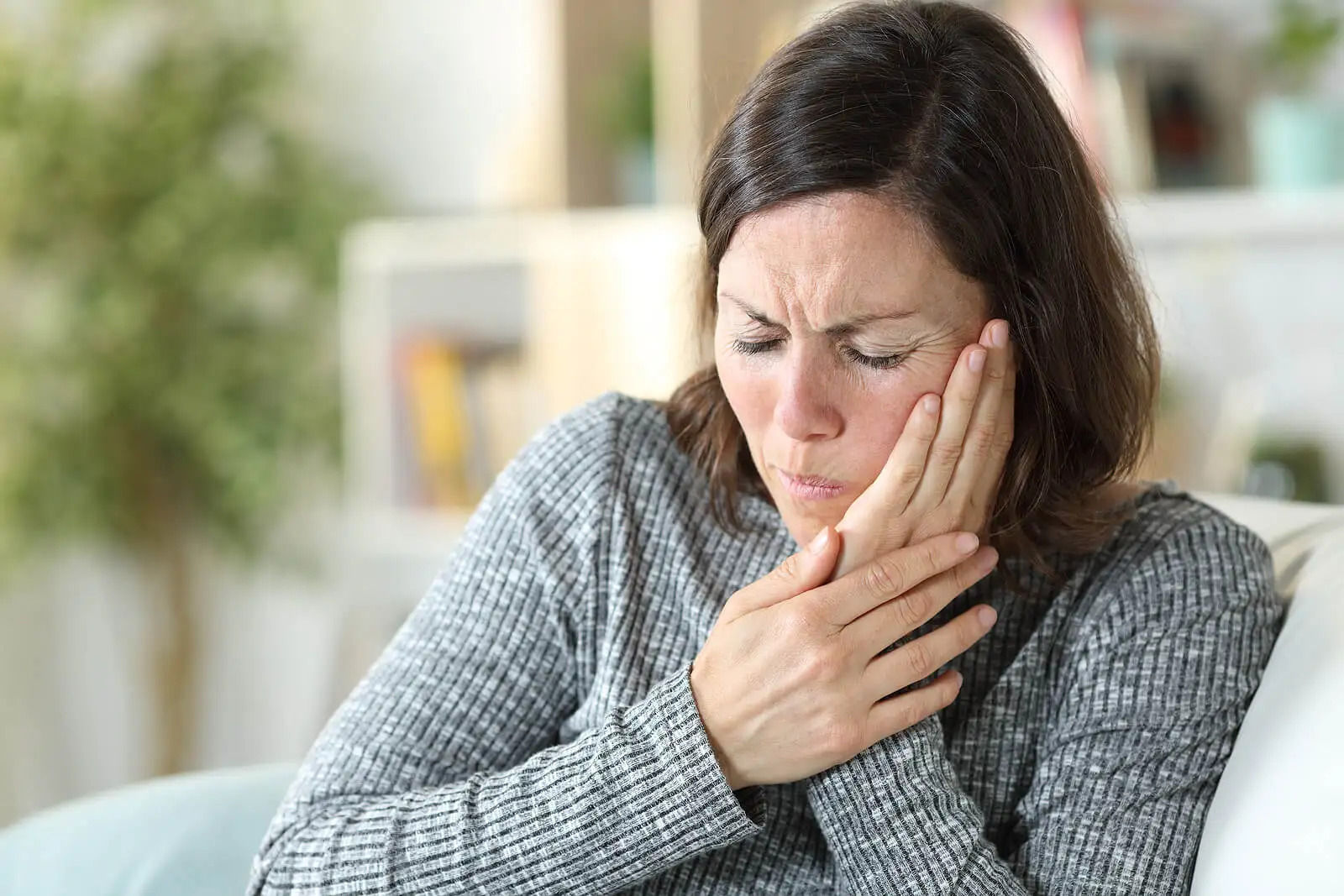The 8 Most Common Dental Emergencies and How to Treat Them


Written and verified by the dentist Vanesa Evangelina Buffa
Even if we scrupulously look after our oral health, dental emergencies can still catch us unawares. We can all suffer accidents and these can have repercussions on our oral health.
Going through dental emergencies can be complicated. Pain, anxiety, and nervousness often take over. That’s why it’s essential to have the necessary information to react calmly and know what to do in each case.
In this article, we’ll tell you about the 8 most frequent dental emergencies and what you should do if they happen to you. Read on and find out more.
What are dental emergencies?
Dental emergencies are conditions that occur in the mouth and which require immediate attention. They’re situations that aren’t life-threatening, but do require prompt action.
To identify them, the presence of some characteristic symptoms that hinder the proper functioning of the mouth should be considered. Pain, inflammation, swelling of the tissues, bleeding and hemorrhage in some area(s) are some of these manifestations one should be attentive to.
Infections and trauma are also situations that are considered dental emergencies. They require you to act quickly and seek professional help as soon as possible.
Given the acuity or severity of these cases, the first thing to do in a dental emergency is to go to the dentist.
The problems that we’re going to tell you about require the intervention of a professional to control and contain the situation. After the most critical moment has passed, other specific treatments will be necessary to restore oral health.
Seeing a dentist as soon as possible improves the prognosis of the problem. The faster the intervention, the better the chances of success. In addition, the risk of suffering complications is reduced.
In any case, until you can get to the dentist, there are some actions you can implement to improve the situation. Here are the 8 most common dental emergencies and what you can do in each case.
The 8 most common dental emergencies
1. Pain
Toothache is one of the most common dental emergencies. In general, this type of condition is usually associated with the presence of caries. However, it can also occur due to other reasons, such as infection or the eruption of wisdom teeth.
Sensitivity to cold, hot, or sweet foods usually precedes the more acute and sustained pain. That’s why it’s a good idea to consult your dentist as soon as you feel any discomfort in your mouth. This will prevent the unpleasant sensation from increasing.
In any case, if the pain appears abruptly and becomes unbearable, the first thing you should do is make an appointment with the dentist. And, in the meantime, there are some things you can do until you can get to see the dentist.
Avoiding very cold, sweet, hard, or hot foods is one way to reduce discomfort. If there’s inflammation in the mucosa or the face, then applying a cold compress to the area reduces the symptoms.
It’s also recommended not to put pressure on the area, and it’s not advisable to lie on that side of the face.
In addition, brushing your teeth and rinsing your mouth with warm water is a simple remedy that helps to remove any residue that may increase the discomfort. Likewise, it’s advisable to floss between the teeth to remove any debris that may be exerting pressure.
Never place medications (such as aspirin or ibuprofen) or natural remedies inside the cavities. Direct contact of the tooth tissues with these substances can worsen and complicate the situation. Neither is it a good idea to take medication without the dentist’s advice.
When you visit the dentist, they’ll look for the source of the pain and proceed to carry out the appropriate treatment. In the case of extensive cavities, fillings, root canals or, in the most severe cases, tooth extraction may be necessary.
In some cases, the dentist will prescribe anti-inflammatory drugs to reduce discomfort. And, if the problem has been caused by an infection, the use of antibiotics will also be necessary.

2. Infections
The death of teeth due to large caries processes, a blow, poorly performed root canals, or very extensive fillings can lead to infections in the mouth. They can also arise from untreated periodontitis or be associated with the complicated eruption of third molars, resulting in pericoronitis.
Infections in the mouth cause the accumulation of pus and abscesses. The presence of this putrefied liquid should be treated immediately.
If not, the patient’s discomfort will only increase. They can also spread and compromise other parts of the mouth and the rest of the body, putting at risk the person’s general health.
The presence of an abscess in the mouth is characterized by pain and an enlargement of the area, which can extend to the face or neck. There’s also often pus and bad breath.
As soon as any sign of infection is noticed, professional treatment should be sought. The use of antibiotics will be necessary. And the best therapy will be applied according to what has originated the whole process.
At home, the best thing is to rinse with warm water and salt to help draw out the pus. If the area is inflamed, cold compresses should be placed on the face to reduce swelling.
Never self-medicate. And, even if you notice that the pain subsides on its own, don’t delay a visit to the dentist. Without dental treatment, the infection won’t go away.
Find out more about the 7 Symptoms that Signal a Dental Infection
3. Tooth fracture
Receiving a blow to the mouth can cause one or more teeth to fracture. The teeth can also break when biting down on something very hard, especially if they’re weakened by decay or previous treatment. And, when a tooth breaks, it’s necessary to treat it gently.
Tooth fractures affect aesthetics as well as oral functions. But they can also cause damage to more internal structures.
Although, at first glance, the problem may not seem serious, dental trauma can affect the dental pulp. If it isn’t treated in a timely manner, it can lead to the loss of the tooth. That’s why an immediate dental evaluation is necessary after the blow.
Depending on the severity of the injury, the tissues involved, and the type of dentition affected (if it’s a permanent tooth or a baby tooth), the dentist will determine the best treatment for each case. Sometimes fillings, root canals, or crowns will be necessary. And check ups over time will help to assess the evolution of the case and rule out late complications.
What to do if I break a tooth?
The moment when the blow occurs in the mouth usually becomes a tense difficult situation. It’s common for there to be injuries to the soft tissues, as well as blood and pain. However, despite these seemingly alarming manifestations, it’s essential to remain calm and act with knowledge and determination.
The first thing to do is to contact the dentist to tell them what happened and schedule an immediate evaluation. When calling them, they may give you some steps to follow until you get to the clinic.
In general, it’s recommended to rinse the mouth with warm water and clean the wounds on the lips and gums. By stopping the bleeding, you can assess the situation more clearly.
If possible, look to see if there’s a dislodged piece of tooth and gently clean it. The practitioner may consider using this piece to reconstruct the broken piece. Applying a cold compress to the area of the blow helps to combat inflammation and reduce pain.
Find out more: The Dental Nerve and Toothaches: Causes and Treatments
4. The loss of a tooth
When receiving a very strong blow to the mouth, one or more teeth can be knocked out. This is known in dentistry as “dental avulsion“ and is another dental emergency we need to know how to deal with.
To improve the prognosis of this problem, it’s essential to act very quickly. In these cases, the tooth must be rushed to the nearest dental clinic. The less time the tooth is out of the mouth, the better the chances of successfully repositioning it.
As in the previous case, it’s essential to communicate with the dentist and tell them what happened. They’ll tell you what you need to do before arriving at the clinic, and will be waiting for you to act promptly.
It’s important to gently clean the injured area and place a clean gauze to stop the bleeding. Don’t exert too much pressure or touch the area.
In addition, you should look for the tooth expelled, picking it up by the upper part, and not touching the root. Try to touch it as little as possible and don’t try to clean it.
It should be transported in a glass with milk or a physiological solution. If this isn’t possible, it can also be placed inside the mouth, under the tongue, taking care not to swallow it.
It isn’t recommended to place the tooth inside the gum orifice. There’s a risk of swallowing it or damaging the structures needed for reimplantation.
Upon arrival at the clinic, the dentist will evaluate whether the lost tooth can be repositioned and fixed in place. If this isn’t possible, they’ll offer other alternatives to restore the affected aesthetics and function.
5. The loosening of a tooth
Another dental emergency that can arise as a result of a blow to the mouth is the loosening of a tooth. When a tooth suffers an impact in the oral cavity, the tooth may move without actually coming out or breaking.
That’s why it’s essential to go to the dentist after a blow. They’ll be able to evaluate the severity of the situation and how all the oral structures have been affected. In order to do this, they won’t only examine the mouth, but dental x-rays will also be necessary to establish the state of the root and bone.
When realizing you have a loose tooth, don’t touch it or move it with your hand or tongue. Biting pressure should also be avoided.
In general, the treatment for these situations is the repositioning of the tooth in its correct position. And then splints are placed that immobilize it for a while to favor the recovery of the tissues.

6. Soft tissue injuries
Accidentally injuring the lips or tongue is a common occurrence. Biting while eating or talking or hitting while playing sports are situations that can lead to cut, bleeding and sore mucous membranes.
These are usually small wounds that resolve by themselves within a few minutes. Its recommended to rinse the mouth with water and apply pressure with gauze to stop the bleeding. In addition, applying cold reduces discomfort and promotes recovery.
But if the wound is very large and the bleeding doesn’t stop, it’ll be necessary to seek professional help. A few stitches may be required to help close the injury.
7. Foreign body between the teeth
It’s true that this isn’t really a dental emergency, but the presence of a foreign body in the spaces between the teeth is a very uncomfortable and even painful situation. Having said that, if not removed, it could cause problems that would require treatment later on.
Having the habit of biting your nails or putting certain objects in your mouth can cause a fragment to get trapped between the teeth. Small seeds or fish bones can also be the intruders that end up trapped.
The pressure exerted by these objects on the teeth causes discomfort and pain. That’s why it’s necessary to remove them.
To do this, it’s best to try to remove the foreign body with dental floss. This should be done gently so as not to damage the teeth and gums.
No sharp or pointed objects should be used for this purpose.
If it isn’t possible to remove the foreign body at home, you’ll need to visit the dentist. Its presence between the teeth will inflame the gum and complicate the situation.
8. Orthodontic dental emergencies
Patients undergoing orthodontic treatment are more likely to suffer dental emergencies caused by their appliances. These emergencies should be dealt with lightly so as not to jeopardize the continuity of the treatment.
The fall or breakage of any of the elements of the appliance is a fairly common situation. If a piece of a brace comes off, an attempt should be made to recover the fragment. In addition, the orthodontist should be informed of the problem so that they can evaluate the possibility of repositioning it at the next check-up or if the visit should be brought forward.
Very long wires or the rubbing of the braces against the cheeks can injure them. These wounds are very painful and annoying.
It’s advisable to use orthodontic wax or gauze to avoid these traumas. And visit the orthodontist to improve the condition of the appliance. If the wire has penetrated the gum, tongue, or cheek, you should go immediately to the clinic.
Prevent dental emergencies
Now you know what to do if you suffer any of the dental emergencies that we’ve told you about here. However, with certain precautions, this type of inconvenience can be prevented.
Here are some tips that can help you prevent these situations:
- Maintain proper oral hygiene to avoid cavities and infections.
- Visit the dentist regularly to detect any problems early.
- Avoid eating hard foods or biting on foreign objects.
- Don’t use your teeth to cut or open things.
- Wear mouthguards when playing sports or risky activities.
- Always wear your seat belt.
If any of the dental emergencies we mentioned above do occur, you already have the information you need to know what to do. Remember that acting calmly will help you make the right decisions.
All cited sources were thoroughly reviewed by our team to ensure their quality, reliability, currency, and validity. The bibliography of this article was considered reliable and of academic or scientific accuracy.
- Herrera Acaro, Y. M. (2022). Protocolos de tratamiento de la avulsión dental en dientes permanentes (Bachelor’s thesis, Universidad de Guayaquil. Facultad Piloto de Odontología).
- Quintanilla, D. G., Villarreal, J. G., Quiroga, M. D. S., Magaña, V. Z., Ramírez, E. N., Villarreal, M. M., … & Soto, J. M. S. (2021). Medios de almacenamiento tras avulsión dental. Contexto Odontológico, 11(22), 5-13.
- Alva, M. A. C., Santos, A. A. C., & Moreira, A. C. (2018). Sensibilidad dentaria: causas y tratamiento. Revista Mexicana de Estomatología, 5(1), 65-67.
- Migueláñez Medrán, B. D. C., Goicoechea García, C., López Sánchez, A., & García, M. (2019). Dolor orofacial en la clínica odontológica. Revista de la Sociedad Española del Dolor, 26(4), 233-242.
- De la Teja-Ángeles, E., Villegas-García, L., Rodríguez-Ramírez, F., & Durán-Gutiérrez, L. A. (2016). Avulsión dental. Acta pediátrica de México, 37(2), 132-133.
- URDANETA, C., & SÁNCHEZ, J. RE-ADHESIÓN DE FRAGMENTO CORONARIO EN DIENTE NO VITAL UTILIZANDO RESINA COMPUESTA.
- Duarte, L. A. J., & Chala, H. E. R. (2018). Reposicionamiento de Fragmentos de la Corona de un Diente Separados por Trauma. Revista Científica Hallazgos21, 3(1), 112-119.
- Infante, M. L., Espinosa, D. R., Pupo, O. L. Z., Velásquez, Y. N., & Santiesteban, Y. D. C. C. (2018). El traumatismo dental como urgencia estomatológica. Correo Científico Médico de Holguín, 22(1), 66-78.
- Lizandro Michel, P. G., & Yenelis, D. L. R. C. (2021, August). LA ATENCIÓN MEDIATA E INMEDIATA DE LA URGENCIA DE ORTODONCIA EN LA ATENCIÓN PRIMARIA DE SALUD. In X Simposio Visión Salud Bucal y IX Taller sobre el Cáncer Bucal 2021.
- Elizabeth, E., & Solís, C. (2020). Manejo de las principales emergencias en la atención odontológica” (Bachelor’s thesis, Universidad Nacional de Chimborazo, 2020).
- Ibarra Busto, M. N., & García Vargas, O. (2020). Emergencias odontopediátricas: traumas vs. condiciones no traumáticas (Doctoral dissertation, Santo Domingo: Universidad Iberoamericana (UNIBE)).
This text is provided for informational purposes only and does not replace consultation with a professional. If in doubt, consult your specialist.








